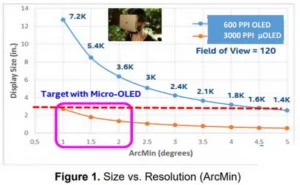Multiple improvements in AR and VR HMDs are required before they can really become mainstream products for either the consumer or enterprise applications. Image quality issues that need to be fixed include brightness (especially for see-through AR displays), resolution (especially for VR displays), contrast, haze, etc. In addition, of course, the HMDs need to be simpler and lower cost to manufacture. Some of the papers that addressed these issues are discussed below.
OLED Microdisplays
Sizes of display panel required to achieve eye-limited resolution in a VR display (Source: SID 2018 paper 40.1)
Paper 40.1 titled “Next Generation Virtual Reality Displays: Challenges and Opportunities” was written by Kunjal Parikh and his colleagues at Intel Corp. This paper was an invited paper (one of three out of four total in the session) in the OLED AR/VR session but it did not discuss a new OLED microdisplay. Instead, it discussed the targets OLED microdisplay manufacturers need to meet to provide the best possible image quality in a VR HMD. The figure above shows the needed display size to achieve high resolution with 600ppi and 3000ppi displays. To achieve eye-limiting resolution of about 1 – 2 arcminutes, the 3000ppi device would need to be 1 – 2” in size while the 600 ppi device would need to be 6.5” – 13” in size to achieve a 120° field of view. 600ppi corresponds to a pixel pitch of about 42µm while 3000ppi corresponds to a pixel pitch of about 8.5µm. This higher resolution is about what the current generation of OLED microdisplays on silicon from eMagin, Kopin and others are achieving, although these companies aren’t yet doing it on 2” (51mm) diagonal silicon substrates with 5K – 7K resolution. (Sony announced a 4000ppi microOLED – a pixel pitch of 6.3μm –just before SID Sony Adds to MicroOLED Range – more details below)
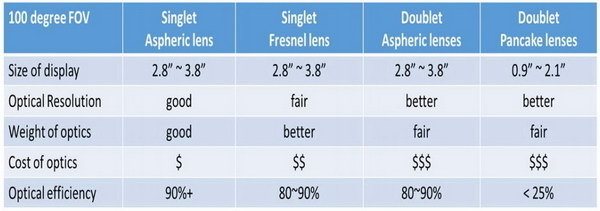 Intel’s comparison of various optical designs for VR HMDs (Source: SID 2018 paper 40.1)
Intel’s comparison of various optical designs for VR HMDs (Source: SID 2018 paper 40.1)
The paper goes on to discuss the optics required to generate a virtual image with a wide FOV and high resolution using one of these large (2”) microdisplays. These optics are not necessarily low cost, high resolution or, perhaps most importantly, light weight and suitable for wearing on your head. While the paper has no obvious errors in it, I was disappointed and would have expected Intel to write a more incisive paper on target AR and VR microdisplay and optics designs.
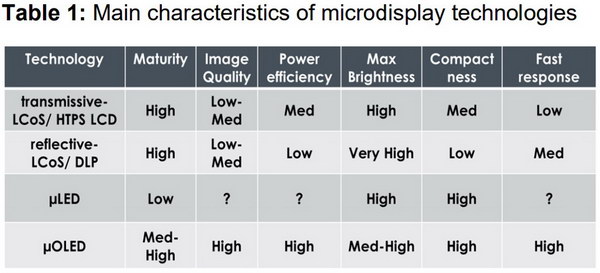 Comparison of microdisplay technologies when used in an AR or VR HMD (Source: SID 2018 paper 40.2)
Comparison of microdisplay technologies when used in an AR or VR HMD (Source: SID 2018 paper 40.2)
Paper 40.2, titled “Microdisplays for Augmented and Virtual Reality” and written by Gunther Haas of MicroOLED S.A.S., was similar to the Intel paper except that it looked beyond just the resolution issue. Again, not surprisingly considering the affiliation of the author, the conclusion was that µOLED displays were the best solution for advanced AR and VR HMDs. MicroOLED was a partner with Fraunhofer and others in a pan-European LOMID project to develop an OLED microdisplay that could target these AR and VR markets. (Fraunhofer introduces new OLED Microdisplay for VR and Large Cost-Effective OLED Microdisplays Project launched by EU)
Not coincidentally, paper 40.5 in this session, titled “High Frame-Rate 1″ WUXGA OLED Microdisplay and Advanced Free-Form Optics for Ultra-Compact VR Headsets” from Philipp Wartenberg at Fraunhofer FEP (Dresden) and his colleagues from Limbak (Spain), MicroOLED (France – Gunther Haas again) and X-Fab Dresden GmbH discussed the results of the Lomid project.
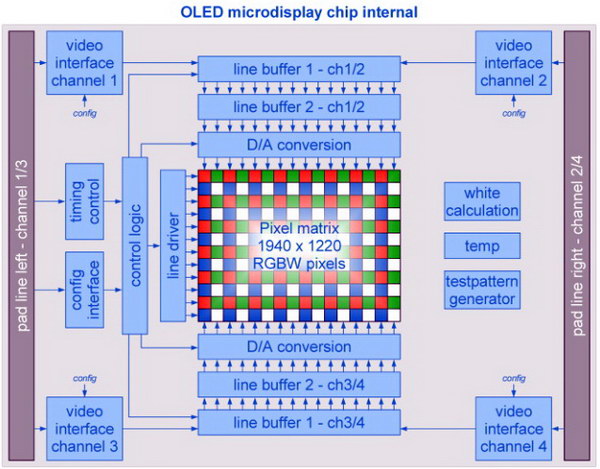 Block Diagram of the new WUXGA OLED microdisplay from the European LOMID project (Source: SID 2018 paper 40.5)
Block Diagram of the new WUXGA OLED microdisplay from the European LOMID project (Source: SID 2018 paper 40.5)
This WUXGA (1920 x 1200) microdisplay had a RGBW pixel pitch of 11µm x 11µm and a sub-pixel pitch of 5.5µm x 5.5µm. The microdisplay as discussed in the paper used white OLED materials and a RGBW color filter array to achieve full color operation. eMagin, however, has shown that once you have an operating silicon backplane, it is possible to replace the color-by-white OLED system with either a monochrome or a direct patterned RGB OLED system, so we can expect one or both of these variations in the future from this group on the same backplane.
 (Source: SID 2018 paper 40.5)
(Source: SID 2018 paper 40.5)
This paper also discussed an optical system intended for high-resolution, wide FOV VR HMDs. The system had two optical channels per eye and was designed to use two of the WUXGA LOMID microdisplays. The two images were seamlessly tiled side-by-side to generate a wide FOV image. This arrangement was said to be simpler and more compact than conventional optics used with larger sized OLED imagers.
 Sony’s new OCCF structure for its OLED microdisplay. (Source: SID 2018 paper 46.3)
Sony’s new OCCF structure for its OLED microdisplay. (Source: SID 2018 paper 46.3)
Paper 46-3 was titled “4032ppi High-Resolution OLED Microdisplay” and was from Takuma Fujii and his colleagues at Sony. This reported that a 0.5” UXGA (1600H x RGB x 1200V) OLED microdisplay has been developed with 6.3μm pixel pitch. The display can be addressed at 120Hz with conventional addressing or at 240Hz with a new dual-line addressing scheme. Display brightness is 2000 cd/m². The microdisplay is color-by-white and uses what Sony calls an On-Chip-Color-Filter (OCCF) structure. This structure puts the color filters closer to the OLED material and is said to reduce the color shift with viewing angle. In addition, the adjacent filters are allowed to overlap with each other slightly, providing a black guard-band between adjacent sub-pixels. While Sony was targeting this microdisplay mainly at camera viewfinder systems with a FOV of about 30°, its high resolution, relatively high brightness and high frame rates also make it suitable for other types of NED systems. The resolution of the microdisplay is on the low side for a VR HMD but the small size and high brightness would allow it to be used in a AR HMD with a limited FOV.
LC Microdisplays
![]() (Source: SID 2018 paper 3-4)
(Source: SID 2018 paper 3-4)
Paper 3.4 titled “Doubling the Pixel Density of Near-eye Displays” was by Tao Zhan and his colleagues at the University of Central Florida. This system uses pixel shift technology, a well known technique in projection displays, to increase the effective resolution and reduce the visible screen door effect in a VR or AR NED. While the technique was nominally display-device technology agnostic, the authors used a polarization-based pixel shift technology, making it more suited for use with a polarized LCD or LCoS NED than an unpolarized OLED or DLP NED. The photo shows three sample images with the pixel shift device turned on and off. In the blow-ups of each image, it is clear that both resolution is increased and the screen door effect is reduced, presenting a “smoother” image.
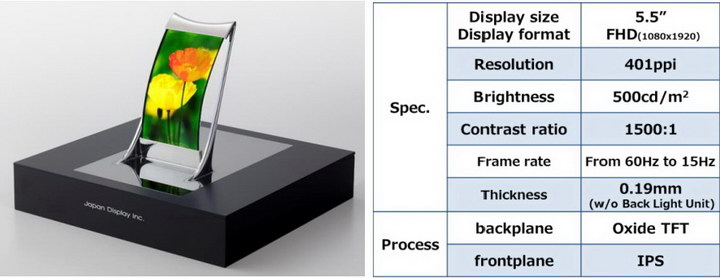 Left: Prototype JDI LCD on a new polyimide substrate. Right: prototype panel specifications. (Source: SID 2018 paper 58-1)
Left: Prototype JDI LCD on a new polyimide substrate. Right: prototype panel specifications. (Source: SID 2018 paper 58-1)
Paper 58-1 titled “High Resolution IPS-LCDs Fabricated with Transparent Polyimide Substrates” was written by Shinichiro Oka, and his colleagues at Japan Display, Inc. While the display isn’t particularly high resolution at 401ppi, it discussed technology that could be extended to higher resolution displays. The paper was about a new polyimide substrate for flexible LCDs that could be used in thinner displays, in this case only 0.19mm thick. Flexibility has two main values. First, in a VR HMD, a slightly curved display makes it easier to design the optics of the system. Second, the paper discusses how a LCD panel with a flexible substrate is less vulnerable to impact damage than a glass display.
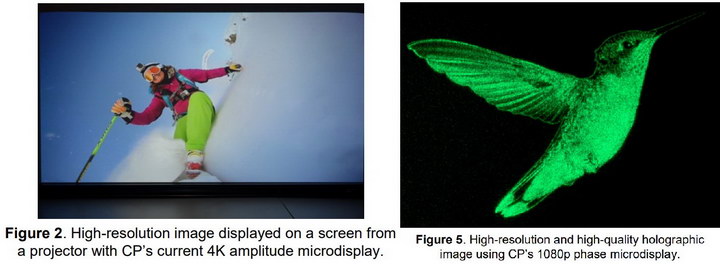 At the oral presentation, the speaker also presented the red and blue versions of figure 5, to demonstrate the ability of the panel to produce a color-sequential, full color holographic image. (Source: SID 2018 paper 58.2)
At the oral presentation, the speaker also presented the red and blue versions of figure 5, to demonstrate the ability of the panel to produce a color-sequential, full color holographic image. (Source: SID 2018 paper 58.2)
The next paper (58-2) was titled “High-Performance Displays for Wearable and HUD Applications” and was by Akheelesh K. Abeeluck and his colleagues at Compound Photonics. It described a high resolution 4K (4096 x 2160) LCoS display designed for color sequential operation. Other versions of the panel are available with 2048 x 1080 or 2048 x 2048 resolution. All versions of the panel have a pixel pitch of 3.015 µm. The panel could work in either an amplitude modulation mode for use in a conventional imaging system or in a phase modulation mode for use in a holographic imaging system. Using CP’s digital drive, the system can have a frame rate of ≥ 120 Hz and a color field rate of ≥ 720 Hz with a display latency of <1mS.
Paper 58-3 was titled “Sub-KHz 4000-PPI LCoS Phase Modulator for Holographic Displays” and was by Jhou-Pu Yang, and his colleagues from the National Chiao Tung University, the University of Central Florida and Jasper Display. The paper discusses a FHD (1920×1080) 0.55-inch LCoS backplane mated to a LC effect with a rise time of 0.60mS and a fall time of 6.51mS. It had a 6.4-μm pixel pitch and 0.2-μm pixel gap for a 94% fill factor. The team also talked about a low-latency digital driver that operated on a 1920 x 640 subset of the chip and provided a field rate of 720Hz.
Paper 58-4 was titled “Active Matrix Field Sequential Color Electrically Suppressed Helix Ferroelectric Liquid Crystal for High Resolution Displays” and was by Liangyu Shi and her colleagues at the Hong Kong University of Science and Technology and AU Optronics Corp. The 3”, 250ppi panel used the fast electrically suppressed ferroelectric liquid crystal (ESHFLC) with a very short response time of ~10µs at 6.67V/µm. In a color-sequential application, this allowed a color field frequency of 360Hz and a frame rate of 60Hz, with each color sub-field tripled to minimize color sequential artifacts. While the ESHFLC LC effect allows the use of an analog drive screen, the fundamental nature of ferroelectric liquid crystals and their dark-field performance allows only a 50% duty cycle on the LEDs used as a backlight for the transmissive panel. AUO targets the panel primarily at the portable mobile market although it also believes the high resolution FSC ESHFLC technology can find additional applications in the emerging virtual reality display market. –Matthew Brennesholtz

